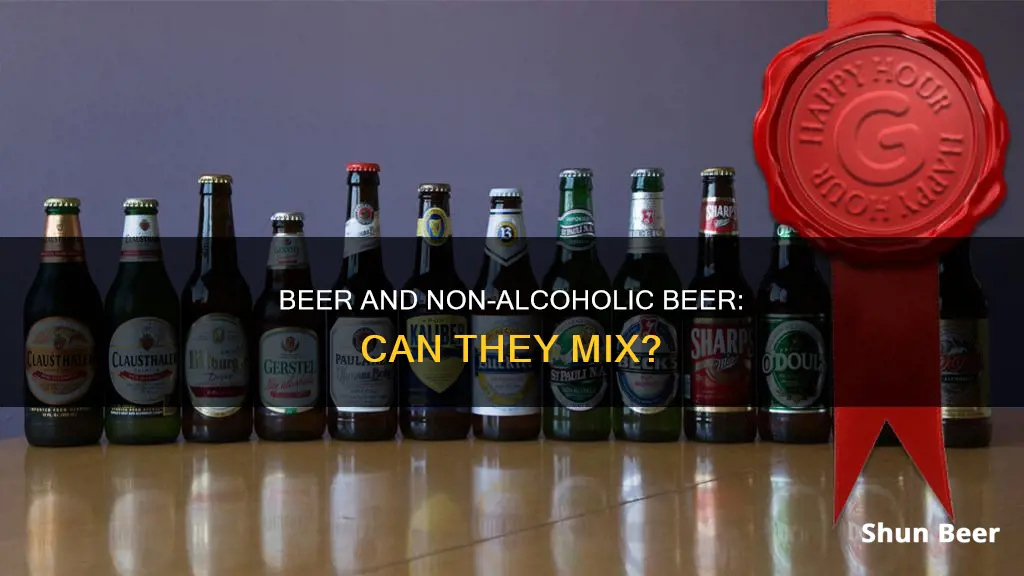
Non-alcoholic beer has been around since the days of Prohibition, but it's having a bit of a moment right now, with sales of non-alcoholic beer up by around 38% in the US in 2020 compared to 2019. But what about mixing non-alcoholic beer with regular beer? Is it safe?
Well, it depends. Non-alcoholic beer is defined as beer with less than 0.5% alcohol by volume (ABV). But that doesn't mean it's alcohol-free. In fact, some non-alcoholic beers have been found to contain up to 1.8% ABV – and many contain more alcohol than they state on the label. So, if you're drinking non-alcoholic beer with regular beer, you may end up consuming more alcohol than you realise.
It's also important to remember that non-alcoholic beer can be a trigger for people with alcohol problems, and it's not recommended for pregnant women.
So, can you drink non-alcoholic beer with regular beer? Technically, yes. But it's important to be aware of the risks and to drink responsibly.
| Characteristics | Values |
|---|---|
| Alcohol content | Non-alcoholic beer typically contains very little or no alcohol, with an alcohol by volume (ABV) of up to 0.5% |
| Taste | Non-alcoholic beer often tastes similar to regular beer |
| Calories | Non-alcoholic beer tends to be lower in calories than regular beer |
| Carbohydrates | Non-alcoholic beer contains more carbohydrates than regular beer, usually in the form of added sugar |
| Risks | Non-alcoholic beer may be unsafe for pregnant women, people with a history of alcohol use problems, and those with liver impairments |
What You'll Learn

Is non-alcoholic beer actually alcohol-free?
Non-alcoholic beer is often presented as a safe alternative to alcoholic beer. While it may be a good option for some people, it's important to be aware that it's not completely alcohol-free and may not be a suitable choice for everyone.
Non-alcoholic beer is typically made by removing the alcohol from regular beer. This can be done through various methods, including heating the beer or using a fine filter to strain out the alcohol. Once the alcohol is removed, the beer is flattened, and carbon dioxide is added to carbonate it. Sugar is also often added to improve the taste, which results in non-alcoholic beer containing more than twice the carbohydrates of regular beer.
By law, non-alcoholic beers sold in the United States can contain up to 0.5% alcohol by volume (ABV). However, many brands claim to offer 0.0% ABV. Despite these claims, research suggests that many non-alcoholic beers contain more alcohol than their labels indicate. One study found that nearly 30% of beverages claiming to contain no or low alcohol had higher alcohol levels than stated, with some containing up to 1.8% ABV.
Who should avoid non-alcoholic beer?
Non-alcoholic beer is not recommended for pregnant women as it may contain small amounts of alcohol, which can pose risks to the developing fetus. It is also not advised for individuals recovering from alcoholism, as the smell and taste of non-alcoholic beer may trigger cravings and lead to a relapse. Additionally, people with alcohol-related liver damage may experience higher blood alcohol levels after consuming non-alcoholic beer.
Non-alcoholic beer can be a good option for people looking to reduce their alcohol intake without giving up the taste and experience of beer. It also tends to be lower in calories than regular beer, although it is not a good choice for those aiming to reduce their calorie intake due to the added sugar. Some studies have also suggested potential health benefits, such as reduced inflammation and improved recovery after exercise, but more research is needed to confirm these effects.
Beer Left Out Overnight: Is It Safe to Drink?
You may want to see also

Is non-alcoholic beer healthier than regular beer?
Non-alcoholic beer is often marketed as a healthier alternative to regular beer, and in some ways, this is true.
Non-alcoholic beer is made by removing the alcohol from regular beer. This can be done by heating the beer, straining the alcohol through a fine filter, or using a process called reverse osmosis, which involves filtering out the water and alcohol and then adding the water back in. Removing the alcohol from beer reduces the risk of chronic disease and the negative health effects associated with alcohol consumption, such as cancer.
However, non-alcoholic beer is not necessarily a healthier option across the board. It often contains more sugar than regular beer, which can lead to a similar number of calories. It also typically contains more carbohydrates, which may be a concern for people watching their carb intake. Additionally, non-alcoholic beer may not be a good choice for people with alcohol use disorders or pregnant women, as it still contains trace amounts of alcohol. Some studies have found that non-alcoholic beer can increase blood alcohol levels, especially in people with liver damage, and may cause people to test positive for alcohol on urine or breath tests.
That being said, non-alcoholic beer does have some potential health benefits. It can be a good option for rehydration after exercise, and some studies suggest that it may have positive effects on sleep, anxiety, and cardiovascular health. It may also be a safe alternative for breastfeeding mothers, although more research is needed in this area.
In conclusion, while non-alcoholic beer may be a healthier alternative to regular beer in some respects, it is important to remember that it is not necessarily a healthy drink. It can still contain calories, carbs, and small amounts of alcohol, and it may not be suitable for everyone. As with any beverage, it is important to consume non-alcoholic beer in moderation and be mindful of the potential risks and benefits.
Drinking Beer on Manhattan Streets: Is It Legal?
You may want to see also

Can pregnant people drink non-alcoholic beer?
Drinking non-alcoholic beer while pregnant is generally not recommended. While non-alcoholic beer contains very little alcohol, it is not completely alcohol-free. In the United States, beverages labelled as "non-alcoholic" can contain up to 0.5% alcohol by volume (ABV).
The American College of Obstetrics and Gynecology (ACOG) recommends that pregnant individuals avoid all alcohol consumption to eliminate the risk of fetal alcohol spectrum disorder (FASD). FASD is an umbrella term for a range of problems that can develop in a child exposed to alcohol in the womb, including facial abnormalities, stunted growth, and behavioural and mental disabilities.
While there is limited research on the specific effects of non-alcoholic beer during pregnancy, the ACOG, the Centers for Disease Control and Prevention (CDC), and the American Academy of Pediatrics (AAP) all agree that no alcohol should be consumed during pregnancy. This includes "non-alcoholic" and "alcohol-free" beverages, as these drinks may contain trace amounts of alcohol.
Additionally, some non-alcoholic beers may contain ingredients that are not considered safe for pregnant individuals. It is always important to check the labels and consult with a healthcare provider before consuming any new drink during pregnancy.
Therefore, while non-alcoholic beer may seem like a tempting option for pregnant individuals, it is generally recommended to avoid it to eliminate any potential risks to the unborn baby.
CO2 Cartridges: How They Keep Beer Fresh and Carbonated
You may want to see also

Can non-alcoholic beer trigger cravings for alcohol?
Non-alcoholic beer is often presented as a safe alternative to alcoholic drinks, but it may not be the best option for everyone. While non-alcoholic beer contains much smaller amounts of alcohol than regular beer, it may still possess some small amounts of alcohol. The amount of alcohol in non-alcoholic beer varies, and it is important to check the labels before consumption. By law, non-alcoholic beers can contain up to 0.5% alcohol by volume (ABV), but some products labelled as 0.0% ABV have been found to contain alcohol.
The smell and taste of non-alcoholic beer are very similar to regular beer, and this can be a trigger for people recovering from alcohol use disorder. Research has shown that the smell of beer may be enough to trigger cravings and a subsequent relapse among certain people with alcohol use disorder. In a study conducted by California scientists, rats were trained to self-administer alcohol when they smelled a certain odour. The researchers found increases in dopamine, a brain chemical associated with feelings of elation and pleasure, in the rats' brains before and after smelling these "alcohol-related cues". While this was an animal study, the results suggest that the smell of non-alcoholic beer may have the potential to trigger cravings in humans as well.
For people recovering from alcohol use disorder, it is important to be aware of triggers and develop strategies to cope with cravings. Some strategies that may be helpful include:
- Recognising and avoiding triggers: Identify people, places, things, or times of day that offer drinking opportunities or remind you of drinking, and try to avoid them, especially in early recovery.
- Distracting yourself: Engage in healthy, alternative activities such as listening to music, reading, going for a walk, watching something funny, or practising a hobby.
- Reaching out for support: Connect with a friend or a trusted person who can provide emotional support and help you ride out a craving.
- Practising mindfulness: Try deep breathing, relaxation exercises, grounding techniques, or physical activity to anchor yourself in the present moment and soothe yourself until the craving passes.
- Building a recovery toolkit: Create a physical or "invisible" toolkit with items or activities that help you manage cravings, such as a comforting book, a favourite snack, a treasured possession, a journal, mindfulness exercises, or affirming mantras.
- Seeking professional help: Consider therapy or counselling to explore long-term changes in alcohol use, address underlying needs, and learn new coping techniques.
While non-alcoholic beer can be a good option for some people, it is important to be aware of the potential risks, especially for those with alcohol use problems or pregnant people. If you are recovering from alcohol use disorder, it may be advisable to avoid non-alcoholic beer and anything that smells like alcohol to prevent triggering cravings and maintain sobriety.
Hoppy Beers: The Secret to Better Beer Bread?
You may want to see also

Can minors drink non-alcoholic beer?
The answer to this question depends on where you live. While federal law in the United States permits minors to consume non-alcoholic beverages, three states (Mississippi, North Dakota, and Ohio) only allow the drinking of non-alcoholic beer for those 18 and older, and 14 states prohibit minors from drinking it altogether.
In the United Kingdom, you do not need ID to buy alcohol under 0.5% ABV.
Even though non-alcoholic beer is permitted for minors in many places, it is worth noting that non-alcoholic beer is not completely alcohol-free. Most non-alcoholic beers contain up to 0.5% alcohol by volume (ABV), and some food products that are regularly consumed by children, such as fruit juices and ripe bananas, can have a similar or higher ABV.
Drinking Beer on a Boat: Florida's Laws
You may want to see also
Frequently asked questions
It depends on which state you are in. Some states allow minors to consume non-alcoholic beer with parental permission or in the presence of a parent or guardian. However, the laws vary from state to state, so it is important to check the specific regulations in your state.
No, non-alcoholic beers typically contain up to 0.5% alcohol by volume (ABV). While this is significantly less than the amount of alcohol in regular beer, it is still enough to be considered an alcoholic beverage in some places.
Non-alcoholic beer may have some health benefits compared to regular beer, such as lower calorie content and reduced risk of cardiovascular disease. However, it is important to note that non-alcoholic beer often contains more sugar and carbohydrates than regular beer, and it is not a healthy drink overall.







